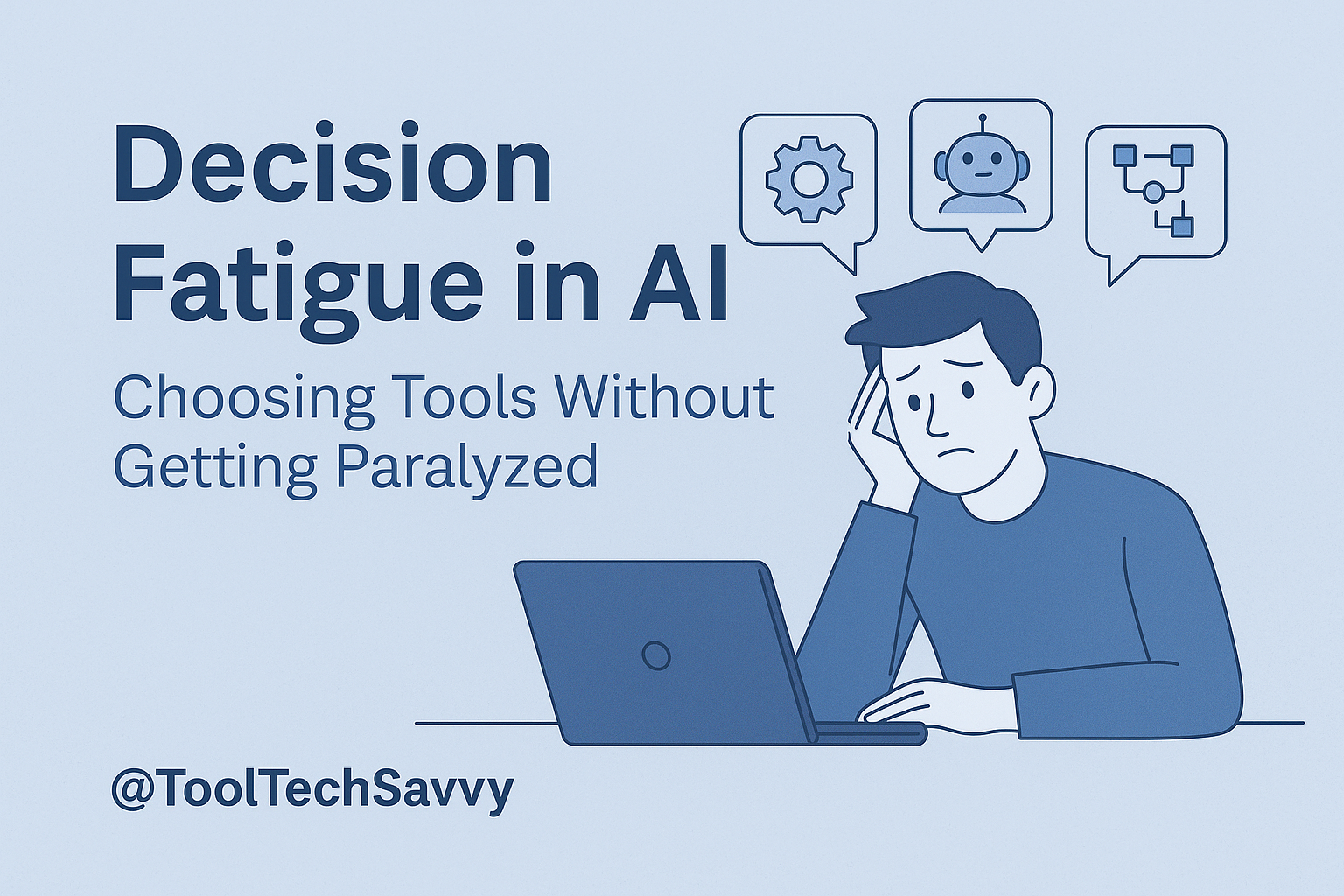In today’s booming AI landscape, every week seems to bring a new “must-try” tool — from AI writing assistants to automation copilots. But as the options multiply, so does our decision fatigue.
Ironically, the technology designed to save us time can end up draining our energy before we even start. Let’s explore why this happens, how to recognize it, and — most importantly — how to make smarter choices without falling into analysis paralysis.
What Is Decision Fatigue (in the AI Era)?
Decision fatigue occurs when the sheer number of choices exhausts our mental energy. The result? You overthink, delay decisions, or abandon them altogether.
In AI, this looks like:
- Spending hours comparing tools that do nearly the same thing.
- Signing up for every free trial but never mastering one platform.
- Constantly switching between apps and losing workflow momentum.
If this sounds familiar, you’re not alone — it’s a common trap for creators, solopreneurs, and tech enthusiasts.
⚙️ Why Too Many AI Tools Can Hurt Productivity
AI promises automation and clarity, yet an overload of options often creates the opposite. For example, choosing between Notion, Trello, or ClickUp for task management can be overwhelming — but clarity comes from matching tools to goals, not trends.
If you’re struggling to pick one, read The Ultimate Guide to Choosing Between Notion, Trello, and ClickUp for a practical breakdown.
Similarly, with AI assistants like ChatGPT, Claude, or Gemini, the problem isn’t lack of innovation — it’s too much good choice. You can simplify the process by learning structured prompt systems, as explained in 7 Proven ChatGPT Techniques Every Advanced User Should Know.
The Psychology Behind Decision Overload
When we make too many small decisions — like comparing AI integrations, pricing plans, or model settings — our brains get tired. Eventually, quality drops even in big choices.
This mental fatigue can lead to:
- Impulse decisions (“I’ll just pick whatever’s trending on X”).
- Indecision (“Maybe I should wait for the next update”).
- Abandonment (“I’ll figure it out later…” — but never do).
AI tools are designed to feel exciting, but they can also trigger “option anxiety.” To avoid that, use constraints. Limit your consideration set to 2–3 tools max and commit to testing one deeply.
How to Make AI Choices Without Overthinking
Here’s a simple process that keeps your focus sharp and your workflow clean:
- Define your use case first.
Don’t start with tools — start with problems. Ask: “What am I trying to automate or improve?”
→ Example: “I want to automate emails” → How to Automate Email Responses with AI (Free Tools). - Pick one category per goal.
For instance, one writing tool, one project manager, and one automation tool.
→ Try How to Use ChatGPT and Zapier to Automate Your Content Calendar. - Test with a short project.
Run a mini experiment — a blog draft, an email sequence, or a content pipeline. If it works, expand. If not, switch once, not five times. - Use AI to manage AI.
Let AI summarize your comparisons. Try prompting ChatGPT: “Compare Notion AI, ClickUp AI, and Trello AI for content planning. Output in a table.” For examples, see Prompt Chaining Made Easy: Learn with Real-World Examples.
The 80/20 Rule of AI Decision-Making
Not every tool is worth your energy. According to the 80/20 principle, 20% of tools drive 80% of your outcomes.
Focus on mastering a few essentials — like ChatGPT, Zapier, and Notion — and ignore the rest until your workflow demands it.
Learn how to apply this mindset in The 80/20 Rule in AI Learning: Focus on What Actually Matters.
Build a Personal AI Stack (and Stick to It)
Instead of chasing every new launch, build your personal AI stack — a curated mix of tools that support your daily flow.
A minimal setup might include:
- ChatGPT – for writing, planning, and idea generation.
- Zapier or Make – for automation.
- Notion or Trello – for organization.
- Perplexity AI – for smarter research (Smarter Search Made Easy).
Once you define this stack, your choices become habits — not hurdles.
Final Thoughts: Simplicity Wins
AI is evolving faster than ever, and it’s easy to feel left behind. But remember: the smartest creators aren’t the ones using every tool — they’re the ones using the right tools consistently.
So next time you’re stuck comparing features or reading endless reviews, pause and ask yourself:
“Will this tool make my process easier — or just busier?”
Focus on clarity, not completeness, and you’ll overcome AI decision fatigue for good.
Related Reads:



